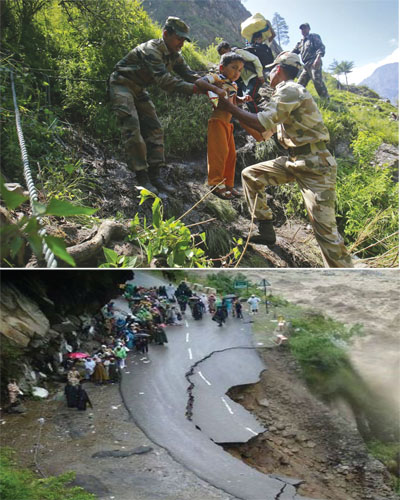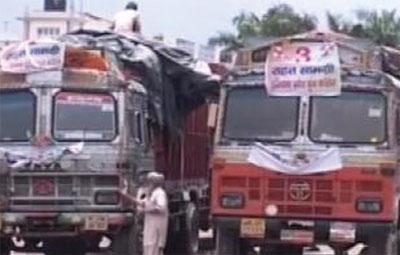
JOSHIMATH (TIP): As the helicopter weaves through the mountains along the Alaknanda valley to this roadhead to Badrinath, what you see can shake the stoutest heart. Village after village lies in ruins. Broken roads, damaged buildings, some of them houses, some shops or schools or infirmaries, twisted electric poles, scattered debris: it is a picture of total devastation.
“Two years back, I took voluntary retirement to settle down in my village. I built a guesthouse here from my savings. This one disaster has taken away everything. My village house has been destroyed too and I am forced to live here in the relief camp,” said Prawesh Rana, a resident of Joshimath. Rana’s story is repeated, with minor variations, again and again. It adds up to a frightening reality of shattered lives — of people who have lost their everything, their homes, life’s savings and even the hope of finding income in the medium term.
Helping these people rebuild their lives is easily the biggest challenge for the state government – in fact, for the whole country. The figures themselves give an idea of the daunting task ahead. Over 2,000 villages have been damaged by the flash floods (the degree of damage varies), said Bhaskaranand, in charge of disaster management and rehabilitation in the state. About 1,500 roads have been washed away and 150 bridges are damaged.
The worst affected are the tourist towns of Kedarnath, Rudraprayag, Uttarkashi, Joshimath and Tehri Garhwal. Agriculture is hard here. And after the floods, the top soil has been washed away. Making these terraced tracts fit for agriculture will take time. The time to sow rajma and potatoes is now. But given the disruption, both in terms of infrastructure and land, this season is likely to be a washout.
For most people here the religious tourism to the Char Dham is a crucial source of livelihood. This year’s as good as lost, but the prospects of tourists returning in the next few years are very dim. With the fear factor looming large, without hotels or inns, people expect the number of pilgrims to drop sharply. Then there’s something that everyone fears: could this calamity have shaken the believer’s faith in the Char Dham yatra, even if for a few years? After all, stories will spread how people came in here with great devotion and met horrendous suffering.
Kanti Singh, one of the survivors, said: “In Kedarnath, at least 67 villages have been washed away. Over the last few years, hundreds of guest houses, hotels and transport businesses had mushroomed there to cater to the needs of the pilgrims. The nature’s wrath has instilled fear in them and shaken their faith for the deity.” Situated in Chamoli district of Uttarakhand, Joshimath is a gateway to pilgrim centre Badrinath and more recently, it has become an attraction for several Himalayan mountain climbing expeditions and trekking trails.
Seeing the tourism boom, many people like Rana had invested in hotels, the transport business and restaurants. According to Udit Ghildiyal, director of the Himalayan Institute for Environment, Ecology and Development, natural disasters have happened here in the past too, the most recent being in August 2012 when flash floods washed away several bridges and houses in Uttarkashi district. “But this one is huge. All the tourist towns, the backbone of Uttarakhand’s economy, have been devastated and we have gone back several years,” he said.
Ghildiyal said that farmers in Uttarakhand have land holding of about 200 square yards on average which isn’t enough for sustenance. “Most people here are dependent on tourism and related business for their livelihood. The government and the army is providing food and medical aid to those affected now but this effort must continue as the tragedy is far from over,” he added. Harsil in Uttarkashi is famous for apples. The crop is ready but is getting wasted as it cannot be transported due to poor road connectivity in the aftermath of the flood.
Many villages are also reporting high incidence of water-borne diseases like diarrhoea. “As of now, there are relief camps nearby where the doctors are available.We also get food from the army and other organisations. What will happen after the evacuations are over?” wonders Swatantra Upadhya, one of the patients getting IV fluid at the relief camp in Gauchar.
Mountain mayhem
June 16-17 | Torrential rains break 88- year-old record. Cloudbursts wreak havoc in Uttarakhand with rivers swelling beyond capacity. Mounds of earth crash into homes, topple trees and buildings. Dehradun records 220 mm of rain. Over 1 lakh pilgrims, including cricketer Harbhajan Singh on a visit to Hemkund Sahib, trapped in Uttarakhand. Three ITBP battalions stationed in state’ upper reaches begin rescue work. Himachal too affected.
State CM, on poll tour, stuck in Kinnaur June 18 | Torrential rains continue. Raging Alaknanda and Bhagirathi engulf scores of hotels. Roads in Kedarnath washed away. Complete communication breakdown. Hundreds of dead bodies found around Kedarnath temple. IAF, Army, NDRF, BRO pressed into rescue work with ITBP. 10 choppers in service, yet air support inadequate June 19 | Rains ease up leaving trail of disaster. Thousands feared dead. IAF doubles number of choppers. Over 10,000 rescued. IAF makes air evacuation, ITBP opens roads June 20 | 45 choppers, 10,000 rescue workers in action.
Over 15,000 evacuated by air and road. ITBP opens trek routes, builds rope bridges. Army, ITBP, NDRF commandos reach inaccessible areas: Rambada, Junglechatti in Kedarnath Valley June 21 | About 16,000 rescued. Forces in Rambada, Junglechetti. New helipads built. More roads opened, bridges built June 22 | Weather turns bad impeding rescue. Death toll crosses 1,000, hundreds of bodies found in Rambada, Junglechatti. Makeshift bridges built by forces break down. Armed forces increase number of choppers to 60. 10,000 rescued June 23 | Close to 12,000 evacuated. Kedarnath valley almost cleared.
Death toll now feared to be 5,000 June 24 | Mass cremation of bodies planned. Rains hamper rescue work, armed forces clocked in over 1,000 flying hours. Worst over June 25 | In tragic chopper accident 20 IAF, ITBP and NDRF personnel — the first to reach Kedarnath for rescue — lose their lives June 26 | Focus shifts to locals as over 600 villages are found to be completely cut off. Mass cremation starts with 30 bodies cremated.
Forces pull out of Kedarnath valley. June 27 | Forces begin pulling out from most areas. NDRF send a special team to extricate bodies from debris. Total 69 cremated since June 26 June 28 | Few sorties due to bad weather. 1,237 wait in Badrinath region for evacuation





Be the first to comment